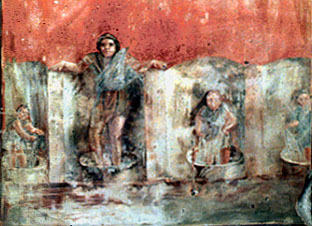2.1 The positive sides of sewage
The remains in Roman sewers have been used to reconstruct the diet of people in ancient cities. Since 2001, the Herculaneum Conservation Project [Tip: hold Ctrl and click a link to open it in a new tab. (Hide tip)] has been excavating the remains of the city, buried by the eruption of Mount Vesuvius in 79 CE.
One of the main problems with the site was water damage, and so they decided to clear and use the Roman sewers which drained the toilets and kitchens of the houses, shops and the public baths in the city. During this work, a large amount of broken pottery – mostly from lamps – and lost objects such as beads, coins, pins and a ring were found. These were mixed up with organic material from human faeces. From the remains, the diet of the inhabitants of Herculaneum can be reconstructed. What was found included:
eggshell fragments, poppy and fig seeds, olive pits, fish bones and scales, pig, sheep and bird bones, with a particular emphasis on chicken bones. More exotic offerings were represented by sea urchin spines and shells.
Most of the eggshells were from chickens. The coprolites had the remains of tiny fishbones, along with fig, grape and mulberry pips.
Sewers don’t only tell us about diet, however. They also hint at some of the diseases from which people in the ancient world suffered. Larvae from weevils were found in ancient bread, while at Carnuntum in Austria – a military base – roundworms and their eggs were found in the sewers.
Sewage could also be beneficial in the ancient world; it was used in agriculture, gardens and – for urine – in fabric manufacture. Cesspits would have had to be emptied regularly, so their contents could be used to fertilise the soil. City dwellers could have sold their waste to farmers, and the process of moving it out of the city would mean paying people to carry it out on carts, so this increased employment opportunities. In the countryside, the connection was more direct. The advice on agriculture given by the Latin writer Varro includes the comment that some people have their slaves use the top of the manure pit as their own toilet (On Agriculture, 1.13.4). Another Latin agricultural writer, Columella, writes on manure:
The orchards, too, and the gardens should be fenced all around and should lie close by, in a place to which there may flow all manure-laden sewage from barnyard and baths, and the watery lees squeezed from olives; for both vegetables and trees thrive on nutriment of this sort too.
Today, human excrement is not used in agriculture because of the risk of disease transmission. When he discusses how to make good manure, Varro recommends not letting the sun heat the manure pile; but in fact the heat kills the pathogens, so this is not good advice.
Urine was used in fabric production and cleaning, because it is rich in nitrogen. The finishing of woollen fabric was carried out by the fuller, whose workshop included terracotta tubs in which the woven fabric would be placed in a mixture of water and urine, or water and fuller’s earth (various types of clay which absorb oils), and then trodden before being rinsed in water. In Ostia, a pipe from a urinal at the Baths of Mithras may have carried urine straight into a fuller’s shop in the basement, but this is the only such example.
The presence of vats of urine on the street, and piles of excrement on fields and gardens, may make you wonder whether people in ancient Greece and Rome simply had a higher level of tolerance for bad smells. But in fact there is evidence to the contrary. Martial mentions a container of urine, destined for a fuller’s shop, lying broken in the road as the first of his list of the worse smells of all (Epigrams, 6.93). Pliny the Younger, when governing a Roman province, wrote to the emperor Trajan about the city of Amastris, concerning an otherwise beautiful street:
Throughout the length of this, however, there runs what is called a stream, but is in fact a filthy sewer, a disgusting eyesore which gives off a noxious stench. The health (salubritas) and appearance alike of the city will benefit if it is covered in, and with your permission this shall be done. I will see that money is not lacking for a large-scale work of such importance.
The emperor gave him permission, but no funding.

